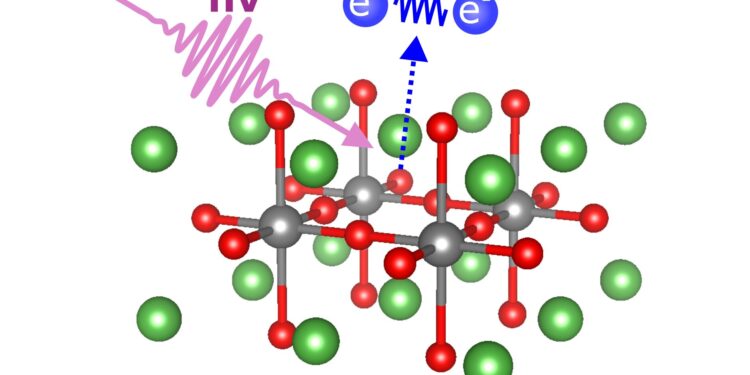A short pulse excites a pair of charge carriers in the oxygen atoms (red). Its energy could be measured. Credit: D. Kühn / HZB
High temperature superconductivity is not yet fully understood. Now, an international research team from BESSY II has measured the energy of charge carrier pairs in undoped La₂CuO₄. Their results revealed that interaction energies within potentially superconducting copper oxide layers are significantly lower than those in insulating lanthanum oxide layers. These results contribute to a better understanding of high-temperature superconductivity and could also be relevant for research on other functional materials.
The research is published in the journal Natural communications.
About 40 years ago, a new class of materials suddenly became famous: high-temperature superconductors. These materials can conduct electricity without any loss, not only at temperatures near absolute zero (0 Kelvin or minus 273 degrees Celsius), but also at much higher temperatures, although well below room temperature.
Such materials are already used in technology. However, the phenomenon is not yet fully understood. However, the role of specific interactions between charge carriers, which ensure their smooth sliding through the crystal lattice under certain conditions, is well established.
Now, an international team led by Professor Alexander Föhlisch from BESSY II has precisely measured the energy of charge carrier pairs on oxygen atoms in an experiment. The University of Rome samples consisted of alternating layers of copper oxide and lanthanum oxide, with the molecular formula La.2CuO4.
When this compound is doped with foreign atoms, it can become superconducting below 40 Kelvin, with superconductivity occurring in the CuO layers while the LaO layers remain insulating. Missing electrons around oxygen atoms, called oxygen holes, are thought to play a central role in superconductivity. The measurements were carried out on undoped La2CuO4 at room temperature.
“We wanted to find out how strong the interactions between the charge carriers in the two different oxide layers are and how they differ,” explains first author Dr. Danilo Kühn, first author of the study, who carried out the measurements at BESSY II as part of the Uppsala-Berlin Joint Laboratory.
For the experiment, the team used time-of-flight spectrometers with a unique configuration to detect electron pairs using Auger photoelectron coincidence spectroscopy. Special pulses of X-rays (PPRE pulses) hit the sample at intervals of several hundred nanoseconds, allowing enough time to carefully measure interaction processes that occur millions of times faster.
“Our method allowed us to analyze these interactions precisely because we selectively observe the relevant copper oxide layer,” explains Kühn. Interaction energies were significantly lower in the copper oxide layer – central to superconductivity – than in the insulating lanthanum oxide layers.
“These results help us to better understand the mechanisms of high-temperature superconductivity,” explains Alexander Föhlisch, and adds: “This measurement technique can also provide information about other functional materials.”
More information:
Danilo Kühn et al, Direct observation of the two-hole Coulomb energy of oxygen 2p on site in La2CuO4, Natural communications (2025). DOI: 10.1038/s41467-025-65314-w
Provided by the Helmholtz Association of German Research Centers
Quote: Charge carrier pairs in cuprate compounds shed light on high-temperature superconductivity (November 7, 2025) retrieved November 8, 2025 from
This document is subject to copyright. Except for fair use for private study or research purposes, no part may be reproduced without written permission. The content is provided for informational purposes only.



